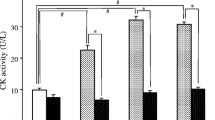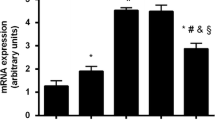Summary
The effects of the carbonic anhydrase inhibitor acetazolamide on basal and parathyroid hormone (PTH)-induced bone metabolism were studied to evaluate the manner in which acetazolamide inhibits bone resorption. Half-calvaria from 5 to 6-day-old mice were cultured using the following treatments: control; acetazolamide (10, 33, or 100 μM); PTH (16.7 nM bovine PTH 1-34); acetazolamide + PTH. The effects of acetazolamide on PTH-induced cAMP accumulation and protein synthesis were determined. Media from bones cultured for 48 hours were analyzed for calcium to assess bone resorption, glucose to assess calvarial glucose utilization, and lactic acid to assess calvarial lactic acid release. Media were also assayed for β-glucuronidase activity as an indicator of lysosomal enzyme release and for lactate dehydrogenase activity as an indicator of cytosolic enzyme release and cytotoxicity. Acetazolamide at 100 μM completely inhibited PTH-induced bone resorption. This inhibition did not appear to be due to cell death, as acetazolamide did not increase lactate dehydrogenase release. Acetazolamide had no effect on PTH-enhanced cAMP levels, indicating that receptor binding and adenylate cyclase activation were unaffected. Acetazolamide alone did not alter calvarial protein synthesis, but did significantly inhibit protein synthesis in the presence of PTH. PTH significantly enhanced calvarial glucose utilization, lactic acid release, and β-glucuronidase release. Acetazolamide inhibited all of these PTH-induced parameters in a manner that roughly paralleled its inhibition of bone resorption; acetazolamide alone had no effect on the basal values. Our results indicate that acetazolamide inhibition of bone resorptionin vitro may involve general alterations in hormonally stimulated bone cell metabolism secondary to carbonic anhydrase inhibition.
Similar content being viewed by others
References
Hall GE, Kenny AD (1985) Role of carbonic anhydrase in bone resorption induced by prostaglandin E2 in vitro. Pharmacology 30:339–347
Hall GE, Kenny AD (1985) Role of carbonic anhydrase in bone resorption induced by 1,25 dihydroxyvitamin D3 in vitro. Calcif Tissue Int 37:134–142
Kenny AD (1985) Role of carbonic anhydrase in bone: partial inhibition of disuse atrophy of bone by parenteral acetazolamide. Calcif Tissue Int 37:126–133
Waite LC, Volkert WA, Kenny AD (1970) Inhibition of bone resorption by acetazolamide in the rat. Endocrinology 87:1129–1139
Mahgoub A, Stern PH (1974) Carbon dioxide and the effect of parathyroid hormone in bone in vitro. Am J Physiol 226:1272–1275
Minkin C, Jennings JM (1972) Carbonic anhydrase and bone remodeling: sulfonamide inhibition of bone resorption in organ culture. Science 176:1031–1033
Anderson RE, Schraer H, Gay CV (1982) Ultrastructural immunocytochemical localization of carbonic anhydrase in normal and calcitonin-treated chick osteoclasts. Anat Rec 204:9–20
Gay CV, Mueller WJ (1974) Carbonic anhydrase and osteoclasts: localization by labeled inhibitor autoradiography. Science 183:432–434
Sly WS, Hewett-Emmett D, Whyte MP, Yu Y-SL, Tashian RE (1983) Carbonic anhydrase II deficiency identified as the primary defect in the autosomal recessive syndrome of osteopetrosis with renal tubular acidosis and cerebral calcification. Proc Natl Acad Sci USA 80:2752–2756
Vaes G (1968) On the mechanisms of bone resorption. The action of parathyroid hormone on the excretion and synthesis of lysosomal enzymes and on the extracellular release of acid by bone cells. J Cell Biol 39:676–697
Fallon MD (1985) Carbonic anhydrase is required for the optimal acidification of osteoclastic extracellular resorbing fluid (ECF). Seventh Annual Meeting of the American Society for Bone and Mineral Research, Washington, DC, Abstract 17
Lerner U, Fredholm BB, Hänström L (1985) Diphenylhydantoin inhibits parathyroid hormone and prostaglandin E2-stimulated bone resorption in mouse calvaria without affecting cyclic AMP formation. J Oral Pathol 14:644–653
Ng B, Hekkelman JW, Heersche JNM (1979) The effect of cortisol on the adenosine 3′,5′-monophosphate response to parathyroid hormone of bone in vitro. Endocrinology 104:1130–1135
Gilman AG (1970) A protein binding assay for adenosine 3′∶5′-cyclic monophosphate. Proc Natl Acad Sci USA 67:305–312
Tovey KC, Oldham KG, Whelen JAM (1974) A simple direct assay for cyclic AMP in plasma and other biological samples using an improved competitive protein binding technique. Clin Chim Acta 56:221–234
Lowry OH, Rosebrough NJ, Farr AL, Randall RJ (1951) Protein measurement with the Folin phenol reagent. J Biol Chem 193:265–275
Gutmann I, Wahlefeld AW (1974) L-(+)-Lactate determination with lactate dehydrogenase and NAD. In: Bergmeyer HU (ed) Methods of enzymatic analysis, Vol 3. Academic Press, New York, San Francisco, London, pp 1464–1468
Robins E, Hirsch HE, Emmons SS (1968) Glycosidases in the nervous system. I. Assay, some properties, and distribution of β-galactosidase, β-glucuronidase, and β-glucosidase. J Biol Chem 243:4246–4252
Maren TH (1979) Use of inhibitors in physiological studies of carbonic anhydrase. Am J Physiol 232:F291-F297
Pierce WM Jr, Blank JA, Waite LC (1985) Effects of heterocyclic sulfonamides on bone metabolism. Res Commun Chem Pathol Pharmacol 50:3–20
Author information
Authors and Affiliations
Rights and permissions
About this article
Cite this article
Hall, G.E., Kenny, A.D. Role of carbonic anhydrase in bone resorption: Effect of acetazolamide on basal and parathyroid hormone-induced bone metabolism. Calcif Tissue Int 40, 212–218 (1987). https://doi.org/10.1007/BF02556624
Received:
Revised:
Issue Date:
DOI: https://doi.org/10.1007/BF02556624




